Look at Amazon and eBay’s websites.
The main page, category and product pages, checkout forms feature the different elements like customers’ testimonials, product reviews, count of purchases, the number of social shares heavily. These elements are the best examples of social proof.
Definition of Social proof.
In a nutshell, social proof is a complex of conversion optimization methods which are based on one simple idea that people tend to trust those who are similar to them or whom they like or accept like an influencer.
How does social proof apply to your marketing strategy?
The best way to motivate your prospects to do something is to claim what other customers in similar situations have done. In other words, try to draw similarities among your prospective clients and existing customers with the help of social proof elements.
Research shows that when humans are unsure what to do, they look around for advice on what should be done. Thus, wisely injected social proof has a tremendous impact on business revenue.
And the social proof statistics confirm this: 89 percent of people say that testimonials, reviews, and other social proof elements influence their purchasing decision. So, injecting social proof tactics builds brand trust among your prospects as well as effectively influences their behavior when it comes to closing deals.
In this article, we’ll run you through 5 ways of how social proof can help your business get more leads by mixing up the social proof with another powerful marketing weapon — social media.
5 Ways to Leverage Social Proof on Social Media
Use Testimonials as social proof on social media
People are confused while trying a new product or service and the first thing that brings them clarity is a review of your product from another customer.
An approving nod from your users, existing or past, in the form of testimonials and ratings, brings a psychological positive impact on the prospects and they are more likely to engage with your brand.
So it is very important to collect and promote testimonials of your happy customers.
How to collect testimonials?
Let’s start from the very beginning: if you’d like to inject social proof to your social media, pick the low-hanging fruit first. Start by enabling customer reviews on your Facebook page (not profile page). This will allow your customers to rate your business and leave the commentary. Then, you can move forward to collect testimonials.
Mainly you can share two types of testimonials to gain the trust of your prospects.
Feature Text Testimonials
This is the simplest way to share the positive feedback you have received from your customers.
You can use the testimonial as it is (without any edit), but if it is a long testimonial then select the portion that highlights your achievement.
Now once you have the right text to post on social media, select a photo of the customer – if you don’t have the photo then ask for it.
It is a good idea to share highlights from your best customer testimonials with a quote formatted into an image.
To publish it on your social media brand page, you can either create a professional post with the help of your designers or just take a screenshot and publish it.
If you want to do-it-yourself, then apps like Canva, Crello, etc will help you to present it in a better format.
You can share this type of posts on a regular basis automatically with the help of social media scheduling tools like SocialPilot which comes with a pre-integrated Canva tool to help you create and publish posts from a single dashboard.
Record Short Videos
You should definitely record video testimonials for three reasons.
First, today videos can be easily shot on cell phones.
Second, studies show video grabs attention for longer than text.
Third, this type of testimonials is vital on platforms that stress real-time content like Snapchat, Facebook, and Instagram Live.
Considering all that, there is no excuse not to embed video testimonials into your website and social media accounts.
Here is a social proof example from Slack.
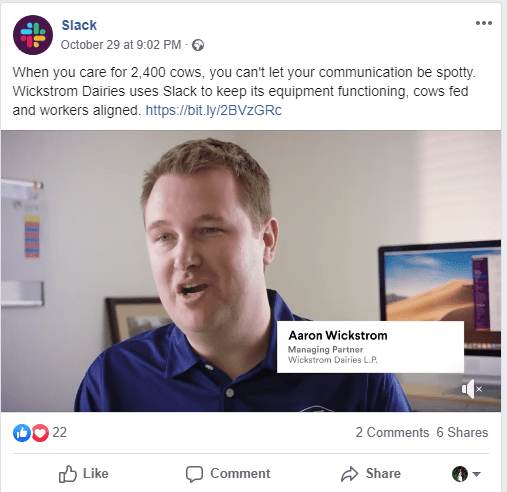
There are a few numbers for your inspiration and motivation:
- 73 percent of B2B businesses using video in their marketing report positive ROI.
- 64 percent of viewers are more likely to purchase after watching a video.
- Video customer testimonials are the most effective type of content, ranking above explainer videos and demonstration videos.
But beyond the statistics, video testimonials influence emotions in the viewer and drive purchasing decisions. Just remember to keep testimonials brief for easy adaptation across multiple platforms and for optimal impact.
How to Gather Video Testimonials in the Blink of an Eye?
Getting a video testimonial can be tricky. The chances are existing customers don’t hurry up to provide you with valuable information. As a result, not every company streamlines the process of collecting this type of clients’ reviews.
Luckily, there is an ocean of tools out there that simplify the video testimonial collection process: Endorsal, Boast, Getbrabo, HippoVideo, etc. In a nutshell, they enable customers to record short videos using their smartphone or webcam easily.
A Few Specific Tips for Sharing Testimonials on Social Networks
We have put together a few valuable tips on featuring text and video testimonials on different social media networks. Feel free to steal them and adopt them into your marketing campaigns.
- Facebook: Here you can organize all your customer text testimonials into an album. What’s more, when it seems appropriate, link them back to your website, for instance, if they are talking about a particular feature or service.
- Twitter: Link your tweets with Facebook posts for the sake of cross -promotion. For instance, mention the customers if you can and include a shortened link directly back to the Facebook post to watch the full text or video testimonial.
Embed Social Media Testimonials to Your Website
Social media itself can be a perfect source of testimonials that confirm the quality of your services. They can positively impact the mindset of prospects before they engage with your company.
Also, highlighting the fact that large numbers of people are already benefiting from your product automatically generates prospects ‘fear of missing out’ (FOMO).
Thus, leverage social posts with the mentions of your brand right on your website like us. Here is how SocialPilot uses We also features tweets and social media praises on our website page:
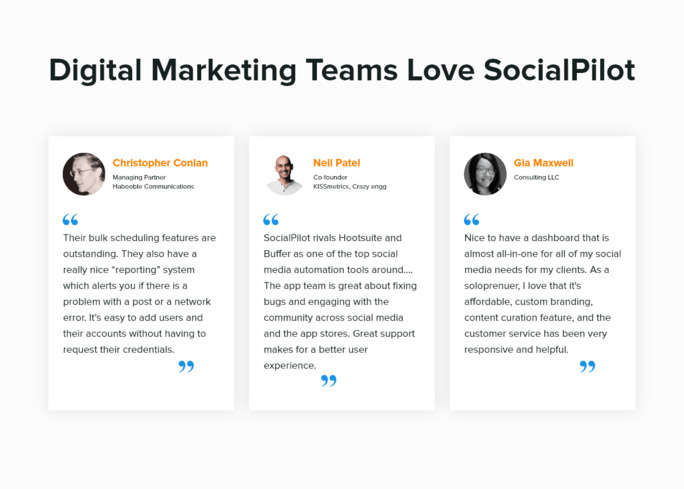
As mentioned above, testimonials are more likely to be believed when they are accompanied by a reviewer`s photo. So, it’s highly recommended to choose social media accounts with real photos. Definitely, you need a bunch of social media testimonials to be able to choose from. To get even more testimonials on social media, you can encourage users to share your branded hashtag and repost users’ social posts on your social accounts.
Here comes the following question: where to place social media testimonials on your website? Choose the place wisely because testimonials can help convince prospects to act and make the purchase.
Here are the top locations you should not overlook:
- Home page. Sure, it’s common to place testimonials here. And for a good reason. Your home page is probably the most viewed place on your website. If you place positive testimonials on your home page, then visitors won’t get a chance to miss them out.
- Product page. Why not showcase positive testimonials on your product pages where prospects make purchasing decisions? The only thing to remember is that social proof should not distract from your product info. Make sure to integrate social media testimonials seamlessly.
- Near calls-to-action. You see contact and sign-up buttons here, there and everywhere. However, these buttons often don’t give you a reason why to make the action they call to. So, feature another satisfied customer right near your call-to-action buttons.
- Testimonial page. If you already have a bunch of testimonials, create a dedicated testimonial page for them. Promoting your clients here, you encourage others to give you more compelling reviews on social media.
Show Follower Counts from Social Media on your Website
Displaying the actual number of social media followers on your website may seem a little bit old-fashioned. Nevertheless, that may help your targeted audience quickly learn how many people like them are interested in what you’re offering. This, in turn, makes your brand more trustworthy. What’s more, website visitors may become your social media followers with just one click.
Use your follower stats to lend credibility to your marketing efforts. Here you can see HubSpot showing, the whopping number of their social followers:
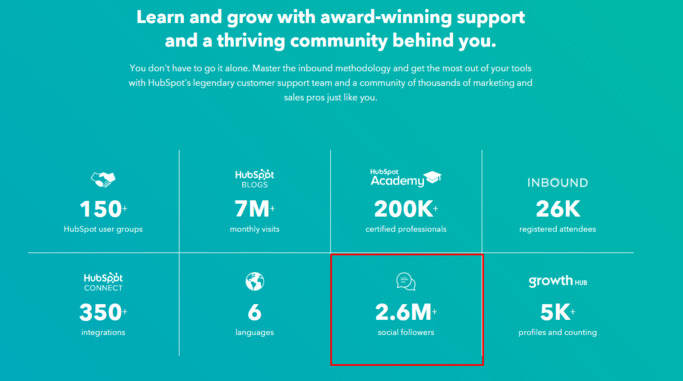
Show the Number of Social Media Shares on your Website Posts
Your popularity among social media followers will convince your prospects to convert. What is the first step you should take? Just add share buttons on your product page or even corporate blog post.
Here is an example of social media share buttons from Backlinko:
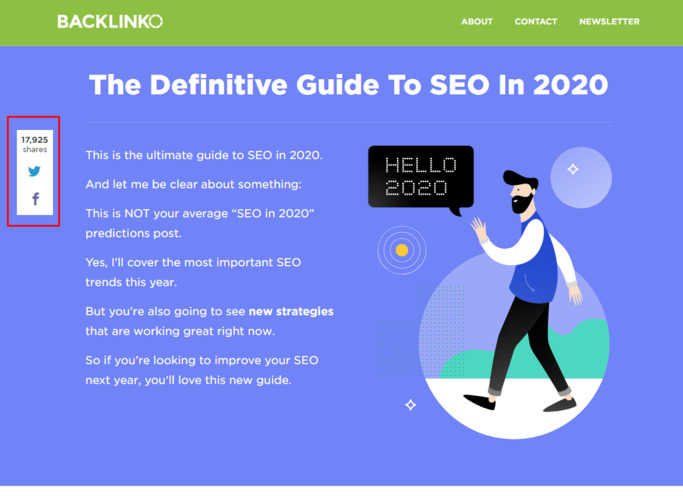
If you have gained a dedicated readership like in the example above, place a counter on your blog posts ASAP to show readers that others find your content worthy of sharing.
But if you’re new to blogging, it is a good idea to have share buttons without the counter.
Include User-Generated Content
The next way to adopt social media for brand credibility is to show your fan base. Brands usually use social media statuses to highlight what their customers are saying about them. For example, Bershka, a clothing retailer company, features their clients’ Instagram posts on a dedicated page:
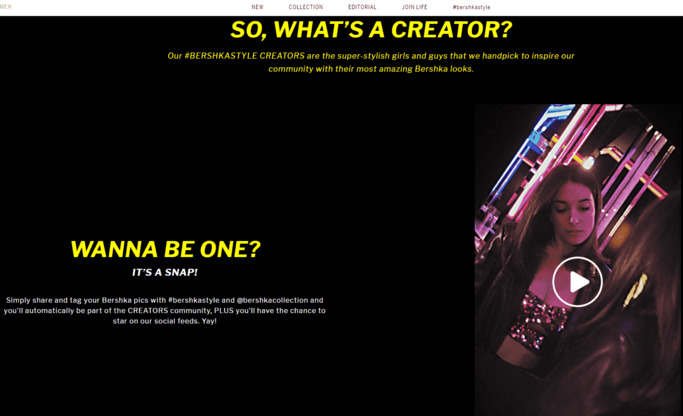
Encourage clients to share the products they’ve purchased and used. This is social proof at it’s best. In addition to building genuine credibility around your brand, user-generated content can inspire prospective customers to buy from you. For instance, HudaBeaty features its clients’ images where they wear makeup created with the help of the brand’s products:
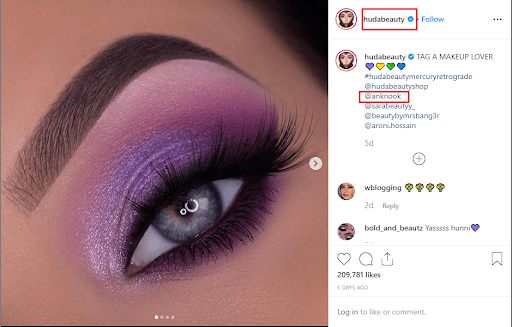
Another type of user-generated content strategy you should adopt is collaborating with social media influencers. The reason is quite obvious: people love and already trust their favorite authors, especially when we talk about micro-influencers, niche-focused (sometimes local) opinion leaders.
Considering that, conduct a little research and find influencers who are in line with the following parameters:
- Their principles are relevant to your business;
- Their followers are real and active;
- They don’t collaborate with your business rivals.
How to Tie it All Together
There are a few safety rules while mixing social proof techniques and your accounts on social media. First, don’t overcrowd your website and social accounts with credibility elements. The less, the more. Avoid the urge to scream, ‘Please trust me!’ loudly. It may have the opposite effect.
Second, remember that different target audiences are affected by different things. So, it’s crucial to have a strong understanding of your customer profile. Know what motivates your prospects and check if you have any of these assets. Whom may they trust? What challenges do they face? Which social networks do they prefer? And so on.
Next, feature those customers with testimonials who truly represent your ideal prospect. People are influenced by similar people. Then, try to avoid negative social proof. For instance, don’t include social media badges if you have followers. Focus on your best assets instead.
And last but not least: by demonstrating your happy clients, you make a promise in advance that your prospect will be satisfied as well. Be honest and accurate in your claims and avoid providing misleading information. In other words, follow through on your promises.
Conclusion
We live in a world where your prospects are looking for social proof as an essential element of page content. And if they don’t find it, they simply won’t convert into paying customers.
In this article, we have walked through some excellent tactics on how to build trust around your company and close more deals with the help of social proof integrated into social media networks. When done well, the above mentioned five ways will transform the perception of your brand. Just keep on A/B testing and figure out what works and what doesn’t.


